Do you know whether you’re a submissive, aggressive, passive-aggressive, manipulative, or an assertive communicator? Is your communication style indirect, direct, controlling, or supporting?
Merely knowing about these divisions isn’t enough to help people identify their communication style. Definitions, while similar, can vary, so it’s necessary to devote each communication style the attention it deserves.
In this guide, we’ll delve into the question, “What are the styles of communication people usually resort to?” and provide a clearer picture using practical communication style examples.
Furthermore, we’ll identify and define communication styles, discuss the positives and negatives of each one, and shed light on how to use that knowledge to better understand and communicate with others. This information can also help others learn how to better connect with you.

- Communication styles are different ways in which people approach the process of communication.
- They serve to teach you how to be self-aware and optimize your communication approach.
- Communication styles are categorized based on the individual’s preferred way of expressing thoughts, ideas, and emotions.
- Psychologist Bourne recognizes 5 different styles of communication: submissive, aggressive, passive-aggressive, manipulative, and assertive.
- Alessandra & Hunsaker recognize 4 types of communication styles — relators, socializers, thinkers, and directors — based on 2 dimensions: direct vs. indirect and supporting vs. controlling.
- Murphy acknowledges 4 communication styles: analytical, intuitive, functional, and personal.
- Author and training consultant Cox outlines 4 styles of communication: action-oriented, process-oriented, people-oriented, and idea-oriented style.
- Business author Dias recognizes 4 distinct styles: expresser, driver, relator, and analytical communication style.
Communication styles: Arriving at a definition
Communication styles are the different ways in which people approach the process of communication, i.e., the process of conveying and taking in ideas and opinions.
If you don’t understand your own communication style, it’s difficult to be self-aware while conversing.
And, if you don’t understand the styles of the people you are conversing with, it isn’t easy to optimize your communication approach.
Much like analyzing different communication models can help us get a better understanding of different aspects of a communication situation and plan for more successful communication, communication styles serve to teach us more about how different styles affect the communication process.
Although people usually favor a specific communication style, learning about the divisions below can aid you in picking up the best aspects of different types.
Let’s see how different psychologists and authors classify communication styles.
5 basic communication styles by Bourne (1995)
According to psychologist Edmund J. Bourne Ph.D. and his book titled The Anxiety and Phobia Workbook, there are 5 different types of communication styles:
- Submissive,
- Aggressive,
- Passive-aggressive,
- Manipulative, and
- Assertive.
According to this communication style theory, these styles of communication may be dominant or used in specific situations or with specific people.

But, why is it important that professionals know about these styles of communication?
Workplace communication is essential for the success of any project. According to research, as many as 86% of employees feel that poor communication is the number one reason behind workplace failure.
The truth is — no one wants to cause communication difficulties. They usually occur due to coworkers’ clashing styles, which can lead to many challenges.
The differences in these styles can cause miscommunication in the workplace, resulting in costly mistakes and missed deadlines. In addition, they can obstruct company workflows, making it impossible to move on to the next stage and finish a project.
Different ways in which employees communicate can also create workplace tension, confusion, and stress, due to teammates not understanding each other’s motives or misinterpreting others’ remarks. In some cases, people may even feel threatened, offended, or underappreciated.
In the long run, this can have a negative effect on a company’s employee retention, customer relationships, internal processes, sales, etc.
For any organization to function at the optimum level, its teams need to bridge these differences, understand different styles of communication, and work on finding common ground. After all, mismatched communication styles in the workplace can make or break any venture.
So, let’s examine what each style is about in greater detail.
🎓 Pumble Pro Tip
Understanding individual communication styles is the first step to bolstering team communication. The next is learning about different channels of communication. Read up on the subject in our guide:
#1 Submissive communication style (aka passive communication style)
The submissive style of communication is focused on pleasing other people and avoiding all conflicts.
For submissive communicators, the needs of others are always more important than their own.
They often act like other people have more rights than them and more means to contribute to conversations, meetings, discussions, and other communication situations.
Common behavioral characteristics of submissive communicators
When it comes to their general behavior, submissive communicators tend to:
- Be apologetic,
- Avoid expressing their feelings, opinions, and desires,
- Avoid confrontations,
- Find it difficult to take on responsibility,
- Have difficulties making decisions,
- Blame others for events and situations,
- Refuse compliments, and
- Feel like victims.
Common non-verbal behavior of submissive communicators
When it comes to their non-verbal behavior, submissive communicators tend to:
- Have a soft voice volume,
- Hold their heads down,
- Twist and fidget,
- Avoid eye contact, and
- Aim to take up as little space as possible to avoid having other people notice them.
🎓 Pumble Pro Tip
Non-verbal behavior is just one out of 5 common types of communication you may encounter in a business setting. To learn more about the different types of communication, check out our extensive guide:
Examples of communication with submissive communicators
As the below examples demonstrate, talking to submissive communicators can be underwhelming.
Example #1: A junior and senior product designer are discussing their latest design solution. To avoid getting herself into a deep discussion that might cause a conflict of opinions, the junior designer ends the discussion by saying: “I’ll let you decide what’s best.”
Example #2: In a marketing meeting, an outreach specialist is given another batch of tasks by the marketing director.
Although the amount of her work is expected to double in the upcoming period because of this, when asked about whether such an amount of work will be too much and whether it’s best to share the tasks with the rest of the outreach team, the SEO outreach specialist simply replies with: “Oh, it’s nothing really, I can easily handle it.”
Example #3: An enterprise sales specialist has been promoted to a new position and given a bigger salary over another specialist who objectively deserved the promotion more.
When asked about this by their immediate colleagues, the enterprise sales specialist who got passed over for the promotion replies: “It’s really not a problem, there’s no need to cause any more trouble.”

Communicate with your team in Pumble
How people who are communicating with submissive communicators feel
Aside from being underwhelmed, people who are communicating with submissive communicators are likely to feel:
- Frustrated that they’ve been told what they want to hear rather than facts,
- Exasperated over their time being wasted on unproductive communication,
- Reluctant to help the submissive communicator make improvements in communication, as their efforts tend to be indirectly rejected,
- Guilty over not knowing what the submissive communicator wants,
- Like they are in a position to take advantage of the submissive communicator, and
- Resentful towards the low energy surrounding the submissive communicator.
Tips for communicating with submissive communicators
To get the most out of your communication with submissive communicators, you can take over the role of the facilitator.
If you want to know what the submissive communicator is really thinking, encourage them to speak by being warm, friendly, and inviting.
For example, in group meetings that involve brainstorming sessions, you can also encourage submissive communicators to share by emphasizing:
“Everyone’s input matters, and there are no stupid ideas, so feel free to share!”
How to be less submissive in communication
While you may be used to submissive behavior in communication and believe you’re being polite and respectful of the other person’s wishes, your perceived unobtrusiveness is actually causing a communication breakdown.
If you want to become a better communicator, you need to acknowledge that you’re a worthy contributor to the conversation.
Don’t be afraid to voice your opinions and respectfully express disagreement. That way, you’ll help both you and your interlocutor by enabling the communication flow and avoiding a build-up of frustration and workplace tension.
You could also work on improving your non-verbal cues by:
- Practicing making eye contact,
- Speaking up, and
- Not fidgeting.
Studies have shown that the way you use your body language can impact your emotions, so you can quite literally fake it until you gain more confidence.
In case of disagreement, you can show respect to the other person by acknowledging their point of view first before expressing your concerns.
You can start in one of the following ways:
“I understand your point of view, but…”
“I see why you might think that, but…”
“Your argument makes sense, however…”
You can always soften your presentation with a smile if you’re afraid you will come across as arrogant or aggressive while voicing your opinion.
Of course, you can’t rely on body language in online communication, but you can use emojis to show that you mean well. Fortunately, team communication apps such as Pumble provide myriads of emojis to help you express a range of emotions in a work-friendly manner.

#2 Aggressive communication style
The aggressive style of communication is focused on winning at all costs — which may often happen at the expense of others.
In contrast to submissive communicators, aggressive communicators value their own needs above everyone else’s and believe their opinions to be the most important in a discussion — which is also how they behave.
They often act like they have more rights and more means to contribute than others. As a result, the importance of the information they are trying to convey may get overshadowed by the inconsiderate way they deliver it.
Common behavioral characteristics of aggressive communicators
When it comes to their general behavior, aggressive communicators tend to:
- Blame others,
- Bully other people,
- Be frightening,
- Be hostile,
- Be threatening,
- Be demanding,
- Be abrasive,
- Be belligerent,
- Be explosive,
- Be unpredictable, and
- Be intimidating.
Common non-verbal behavior of aggressive communicators
When it comes to their non-verbal behavior, aggressive communicators tend to:
- Use a loud voice volume to get their ideas and opinions across,
- Position themselves to seem bigger than others,
- Use prominent, sharp, and fast gestures,
- Scowl, frown, or glare at others,
- Invade other people’s personal space, and
- Make sarcastic remarks.
Examples of communication with aggressive communicators
Aggressive communication style often leads to breaks in communication and an uncomfortable atmosphere, as shown in the examples below.
Example #1: A discussion about product analytics between 2 members of a sales team heats up as the person with an aggressive communication style lashes out at his colleague: “You are crazy! That’s not what the numbers mean!”
Example #2: A sales manager provides feedback to the new sales team member without much tact. The new sales specialist gets upset, to which the sales manager replies: “Stop being whiny! You make me sick!”
Example #3: An urgent meeting among the university staff about the location for the annual education seminar, which should be decided by vote, ends with the university dean quickly getting bored of the discussion and declaring: “That is just about enough of that! We’ll do it my way!”
In these examples, the aggressive communicators are addressing their subordinates. This negatively impacts team morale and motivation, indicating that aggressiveness significantly disrupts workplace communication, especially when present in communication styles in leadership positions.
🎓Pumble Pro Tip
As a leader, you’re expected to know the communication style of your employees and adapt your own to make your employees feel understood, safe and valued so they can really shine. This is especially challenging if you run a remote business. Not sure how to get there? Read all about it on our blog:
How people who are communicating with aggressive communicators feel
The people who are communicating with aggressive communicators are likely to feel:
- They need to be defensive or withdraw from the discussion,
- They need to be aggressive in return and fight back,
- Resentful and vengeful for how hurt, humiliated, and even exploited they feel while interacting with an aggressive communicator,
- Afraid to report mistakes and problems to avoid being blamed for them, and
- Generally less respectful towards someone who communicates aggressively.
Tips for communicating with aggressive communicators
To get the most out of your communication with aggressive communicators, you can actively look out for interruptions and then aim to prevent them.
If the aggressive communicator cuts you off mid-sentence, simply say:
“Hang on, I’m not finished yet.”
Besides this, you should:
- Emphasize your boundaries,
- Never respond in a similarly aggressive manner, and
- Calmly voice your needs and feelings.
How to be less aggressive in communication
A conversation needs to flow both ways to be successful. If you’re aware that your communication style is too aggressive, you’re already much closer to becoming a better communicator.
It’s best to start by examining your aggressive tendencies and what causes them.
In the meantime, you can make an effort to become friendlier, more approachable, and less threatening in many ways.
Start by practicing active listening and truly acknowledging other people’s ideas and feelings.
Then, work on your empathy by putting yourself in others’ shoes and taking a moment to reflect before resorting to explosive behavior, hurting, or demeaning someone.
However, you may also be exhibiting aggressive behavior without even realizing it, especially in online communication.
For example, following up on a non-urgent issue by mentioning (e.g. @JohnSmith) someone in a public Pumble channel persistently may come across as annoying and aggressive. It’s best to limit your follow-ups or DM the person.
You should also be careful about how you use the @channel mention. For example, is the notification so important as to ping the members who are currently away? If not, you can use the @here option and not disturb people during their breaks or off-hours.

Another type of aggressive behavior to steer clear of is making “edgy” jokes in the team’s more informal channels. They can easily come across as insensitive and turn out to be offensive to some members of the channel.
#3 Passive-aggressive communication style
The passive-aggressive communication style involves people appearing passive on the surface while actually expressing their anger indirectly.
Passive-aggressive communicators act this way because they want to act more directly, but find themselves powerless to do so — usually because of untimely circumstances.
To vent their anger and dissatisfaction, passive-aggressive communicators subtly undermine the person they are communicating with, even if this means they’ll worsen their own situation.
Common behavioral characteristics of passive-aggressive communicators
When it comes to their general behavior, passive-aggressive communicators tend to:
- Be indirectly aggressive,
- Be sarcastic or ironic,
- Be devious,
- Be unreliable,
- Be sulky,
- Be patronizing,
- Be two-faced (e.g., they are nice to your face but are secretly trying to sabotage your work efforts or spread rumors about you),
- Complain more than other people,
- Like gossiping, and
- Invest efforts into actively harming the other person.
Common non-verbal behavior of passive-aggressive communicators
When it comes to their non-verbal behavior, passive-aggressive communicators tend to:
- Speak with a sugary sweet voice to mask their true intentions and feelings towards you,
- Position themselves asymmetrically (e.g., hip thrust out, hand on hip), especially when being patronizing,
- Have quick and unexpected gestures,
- Invest extra effort to look sweet and innocent, and
- Stand close during face-to-face conversations to elicit a false sense of warmth and friendliness.
Examples of communication with passive-aggressive communicators
Being on the receiving end of passive communication and aggressive behavior is far from pleasant, as evidenced by examples below.
Example #1: A back-end software developer is talking with a front-end software developer about the fixes that need to be done on the latest feature of their travel app.
The front-end developer seems to agree with the proposed solutions but confuses the back-end developer by ending the conversation with: “OK, we’ll do it your way! After all, you always know better than me.”
Example #2: An emergency physician is finishing their shift. They have trouble opening their office and tell a nearby emergency room nurse: “Oh, don’t worry about me. I’ll figure this out on my own like I always have to.”
Example #3: A college professor with a Ph.D. undermines a college assistant who’s yet to obtain their Ph.D. degree by saying: “You did brilliantly for someone of your education and experience.”
This is a microaggression, and the following section will explore how such behavior affects others.
How people who are communicating with passive-aggressive communicators feel
The people who are communicating with passive-aggressive communicators are likely to feel:
- Confused at the contrast between what the passive-aggressive communicators are saying and what they are actually communicating,
- Hurt and resentful when they realize that contrast is deliberate, and
- Angry when the behavior persists — to such an extent that they may want to retaliate.
Tips for communicating with passive-aggressive communicators
To have productive conversations and meetings with passive-aggressive communicators, you should ask them to be direct.
If the passive-aggressive communicator is constantly late for meetings (which may indicate they dislike the location, time, or how the meetings are conducted), confront them about this directly:
“Sarah, I’d appreciate it if you were to arrive on time to meetings. Is there a specific reason why you tend to be late?”
You may also want to confront them in private to lower the chances that the passive-aggressive communicator will become defensive.
🎓 Pumble Pro Tip
No matter the type of communicator you’re dealing with, setting clear boundaries and establishing rules in the workplace can only be done through direct communication. Learn more about how to easily adopt this style of communication by reading our article on the topic:
How to be less passive-aggressive in communication
People often resort to this style of communication to avoid confrontation, but a passive-aggressive communication style is a kind of aggressive behavior.
If you catch yourself being passive-aggressive often, you need to work on becoming better at communicating your frustrations and being direct.
Remember — expressing dissatisfaction doesn’t have to result in conflict. It’s much better to be direct about what’s bothering you, resolve it right away, and keep passive communication at bay.
For example, say you’re in Sarah’s shoes and are always late to meetings because you dislike the time of the sessions. Here’s how you could handle the situation in 3 simple steps:
- Ask why. Ask if there’s a particular reason why meetings need to take place at that time, expressing genuine curiosity.
- State your point of view. Say why it might make more sense to move the meetings to another time slot.
- Request a change if your argument stands. Ask to move the meetings.

Promote more effective team communication with Pumble
Passive-aggressive cues can sneak up on you even in online communication — like in Pumble channels. Did you know that many emojis now read as passive-aggressive, and you should avoid them?
The classic smiley face (🙂) has become synonymous with sarcasm, irony, and a patronizing attitude for the younger generation. The upside-down version of it (🙃) is even worse — nothing more frightening than seeing “No problem” followed by this trickster in a chat.
A great alternative that won’t be misinterpreted is the grinning emoji (😁).
🎓 Pumble Pro Tip
Emojis are open to interpretation and, as such, can cause problems in business communication. Read more about this on the blog to prevent communication issues down the line:
#4 Manipulative communication style
The manipulative style of communication involves shrewd behavior a person takes on to achieve the wanted outcomes.
Manipulative communicators will scheme and calculate to influence and control others to do their bidding.
The thoughts, opinions, and ideas they convey may have underlying meanings. Thus, others may not be aware of the ulterior motives at first.
Common behavioral characteristics of manipulative communicators
When it comes to their general behavior, manipulative communicators tend to:
- Be cunning,
- Know exactly how to get what they want from the person they need it from,
- Sulk to elicit certain emotions and reactions from others,
- Ask for what they want or need indirectly,
- Make others feel obliged to them or sorry for them, and
- Fish for compliments.
Common non-verbal behavior of manipulative communicators
Concerning their non-verbal behavior, manipulative communicators usually:
- Have a high-pitched voice that reveals a patronizing or envious streak and
- Have guilty or ashamed facial expressions.
Examples of communication with manipulative communicators
You may wonder how a person with this communication style manipulates their interlocutors. Well, let’s take a look.
Example #1: “I’m sorry, I don’t know how to work the coffee machine.” says a senior bank clerk to their younger coworker who’s just started today. The senior bank clerk knows how the coffee machine works but doesn’t want to show the younger employee. Instead, he wants the new bank clerk to seem incompetent while figuring out how the coffee machine works in front of the bank manager who’s making tea next to them.
Example #2: “I’ve only contacted 100 leads today. I hope I’ll be better tomorrow!” declares a senior sales specialist in front of the director of sales and the rest of the sales team, hoping to encourage them to compliment him.
How people who are communicating with manipulative communicators feel
People who are communicating with manipulative communicators are likely to feel:
- Guilty if it’s hinted they’ve not lived up to the advertised expectations,
- Frustrated, as it’s difficult to tell what a manipulative communicator really wants and how sincere they are being (at least at first),
- Angry or annoyed at the antics of the manipulative communicator — this anger and annoyance may build up to an open conflict, and
- Resentful at the antics of the manipulative communicator, to the point that they may seek retaliation.
Pro tip for communicating with manipulative communicators
To ensure exchanges with manipulative communicators are smooth sailing, you should directly call them out for such behavior.
According to an article by Jamie Cannon MS, LPC, in Psychology Today, you should opt for a script to help you avoid an emotional response. Although not the most genuine communication tool, rehearsed scripts act as a much-needed buffer between you and the manipulator.
You should assess the situation and give a well-crafted response to set clear boundaries and not let your work suffer in the process.
Example #1: When a manipulator tries to play the victim:
“I acknowledge your feelings, but it’s important to take responsibility for our actions.”
Example #2: Dealing with excessive praise for manipulative purposes:
“I appreciate your kind words, but let’s stay focused on the topic at hand.”
Example #3: Dealing with manipulative sarcasm:
“I prefer direct communication. If there’s something on your mind, let’s discuss it openly to avoid any misunderstandings.”

How to be less manipulative in communication
Manipulative behavior might get you what you want at first, but it will breed resentment and distrust from your colleagues in the long run. In many cases, it can have the opposite effect of what you hoped to achieve.
To be a better communicator, you need to:
- Become aware of how you manipulate others and question your motives,
- Ask directly for what you want, instead of trying to appeal to others emotionally and get them to offer their help, and
- Look for the subtle ways you might be manipulating coworkers.
For example, deliberately having people wait for your answer in the chat is manipulative, especially if you’re their higher-up.
Ask yourself what your ulterior motive is. Do you secretly want to make them feel unimportant or have them worry if the question was stupid or if they’ve done something wrong?
On the other hand, when reaching out to a colleague over an app like Pumble, be direct and precise about what you want. Don’t send only a “Hi” and a smiley to trick the person into responding right away, only to trap them in a discussion about a complicated issue that will take away time they may not have.
#5 Assertive communication style
The assertive style of communication emerges from self-esteem and represents the healthiest and most effective style of communication you can adopt.
Assertive communicators are neither too passive nor too aggressive — instead, they communicate directly and effectively without resorting to passive-aggressiveness or manipulation.
Moreover, assertive communicators have equal regard for their own and other people’s needs and rights.
Common behavioral characteristics of assertive communicators:
In terms of their general behavior, assertive communicators typically:
- Aim to fulfill their needs and rights without hurting the needs and rights of others,
- Respect the needs and rights of other people without neglecting their own needs and rights,
- Are socially supportive,
- Are emotionally expressive,
- Make their own decisions, but take full responsibility for the outcomes of their choices,
- Ask for what they want directly, but with regard to others, and
- Have no problems accepting compliments.
Common non-verbal behavior of assertive communicators:
Regarding non-verbal behavior, assertive communicators usually:
- Talk with a medium voice pitch, speed, and volume,
- Have an open, relaxed posture,
- Avoid twisting, fidgeting, or aiming to appear smaller or more imposing than they actually are,
- Maintain eye contact while communicating,
- Have relaxed, natural gestures, and
- Are respectful of other people’s personal space.
Examples of communication with assertive communicators
It’s now time to see what this communication style looks like in action.
Example #1: A customer support specialist is having difficulties focusing on the latest user ticket because the app’s front-end developer is listening to music on their speakers.
The customer support specialist knocks on their cubicle and says: “Please, Linda, could you turn the volume down or use headphones? I’m working on the newest set of user tickets and have difficulties focusing on them because of the music.”
Example #2: A CTO of a time zone converter app wants to have a call with a potential client interested in the self-hosted version of the said app. He asks his product manager to join the call on Friday at 10 a.m..
The product manager replies the following: “Unfortunately no, I’ve taken half of the day off because of a doctor’s appointment. I’ll be available from 1 p.m..”
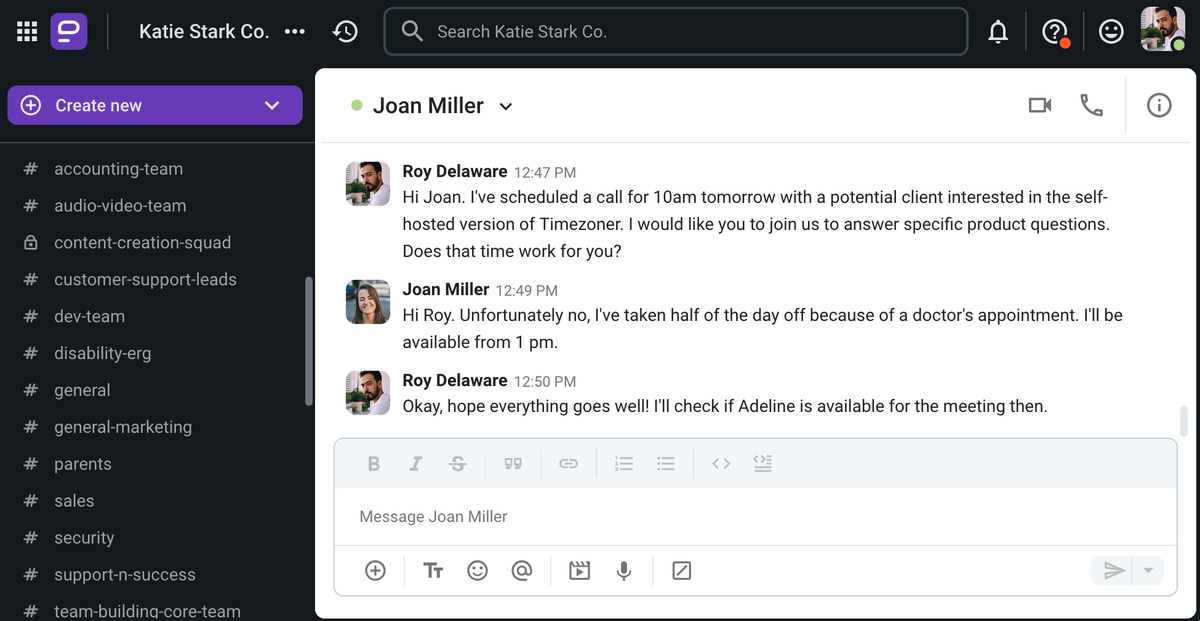
How people who are communicating with assertive communicators feel
The people who are communicating with assertive communicators are likely to feel:
- They can trust the assertive communicator,
- They understand what the person is trying to communicate,
- They can offer criticism without triggering an adverse reaction,
- They can respect the person, and
- They don’t need to go out of their way to make the assertive communicator feel comfortable and secure.
Tips for communicating with assertive communicators
The best you can do when communicating with assertive communicators is to mimic their healthy and efficient style of communication.
In essence, try to:
- Listen to them attentively,
- Positively assert yourself,
- Agree to disagree with them (if applicable),
- Ask for their opinions, and
- Be open and honest in communication.
One example where you assert yourself while inviting others to contribute would be saying:
“I propose we pick this color scheme for the product. What do you think?”
How to be more assertive in communication
No matter your communication style, you can strive to become more assertive. Since assertiveness is built on self-confidence, you need to understand your worth and respect your rights, needs, and wants. However, you also need to respect others to be a successful communicator.
You can start by voicing your opinions, ideas, and concerns and asking for what you want directly and in a neutral tone.
On the other hand, you shouldn’t let your judgment get clouded by frustration and other excessive emotions. If you need time to cool off, take it before you act.
You can express criticism or disagreement without sounding judgmental by using “I” statements. For example, instead of saying, “You have done a terrible job!” you can say:
“I feel you could have done better on this project.”
Learn to say “No” decidedly but politely. If your boss wants to put you on a new project when you’re already busy, you can say something like this:
“While I understand the importance of starting the project early, I won’t be able to begin working on it until I’ve finished my current tasks.”
Then, you can propose a compromise:
“However, I could set up a quick meeting with the team this week to give them a couple of guidelines on how to begin. If that doesn’t work, I can start the new project first thing on Monday. Let me know what you think.”
Respect your time and boundaries, and let your team know they can’t contact you during your break or off-hours. Instead of having your phone vibrate every 2 seconds while you’re trying to eat lunch, pause notifications in the team chat.
On Pumble, you can set up a notification schedule that works for you so that you don’t have to do it manually every day.
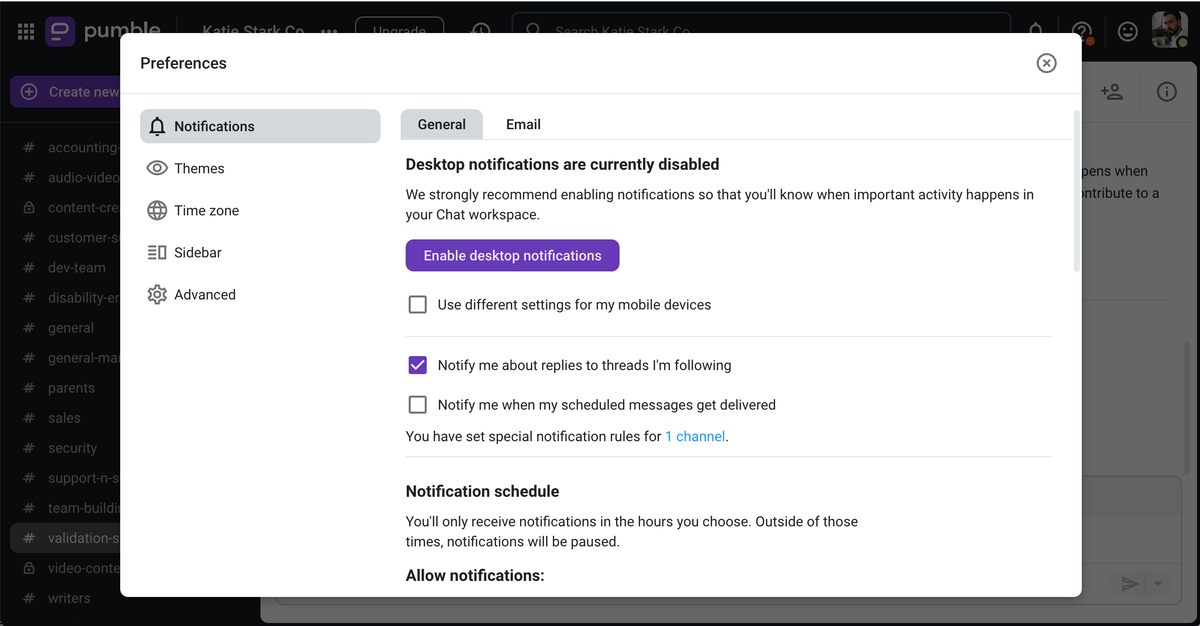
Minimize distractions and prioritize the work that matters most with Pumble
🎓 Pumble Pro Tip
Being assertive can be difficult, especially in remote communication when you can’t always read the non-verbal cues of your interlocutors. Check out our blog post to learn how to draw clear boundaries and communicate assertively in every scenario:
Communication styles by Alessandra & Hunsaker (1993)
According to another communication styles theory, defined by Alessandra & Hunsaker in their book Communication at Work, we recognize 4 types of communication styles, which are based on 2 dimensions:
- Direct vs. indirect styles of communication and
- Supporting vs. controlling styles of communication.
The 4 communication styles in question are:
- Relators,
- Socializers,
- Thinkers, and
- Directors.
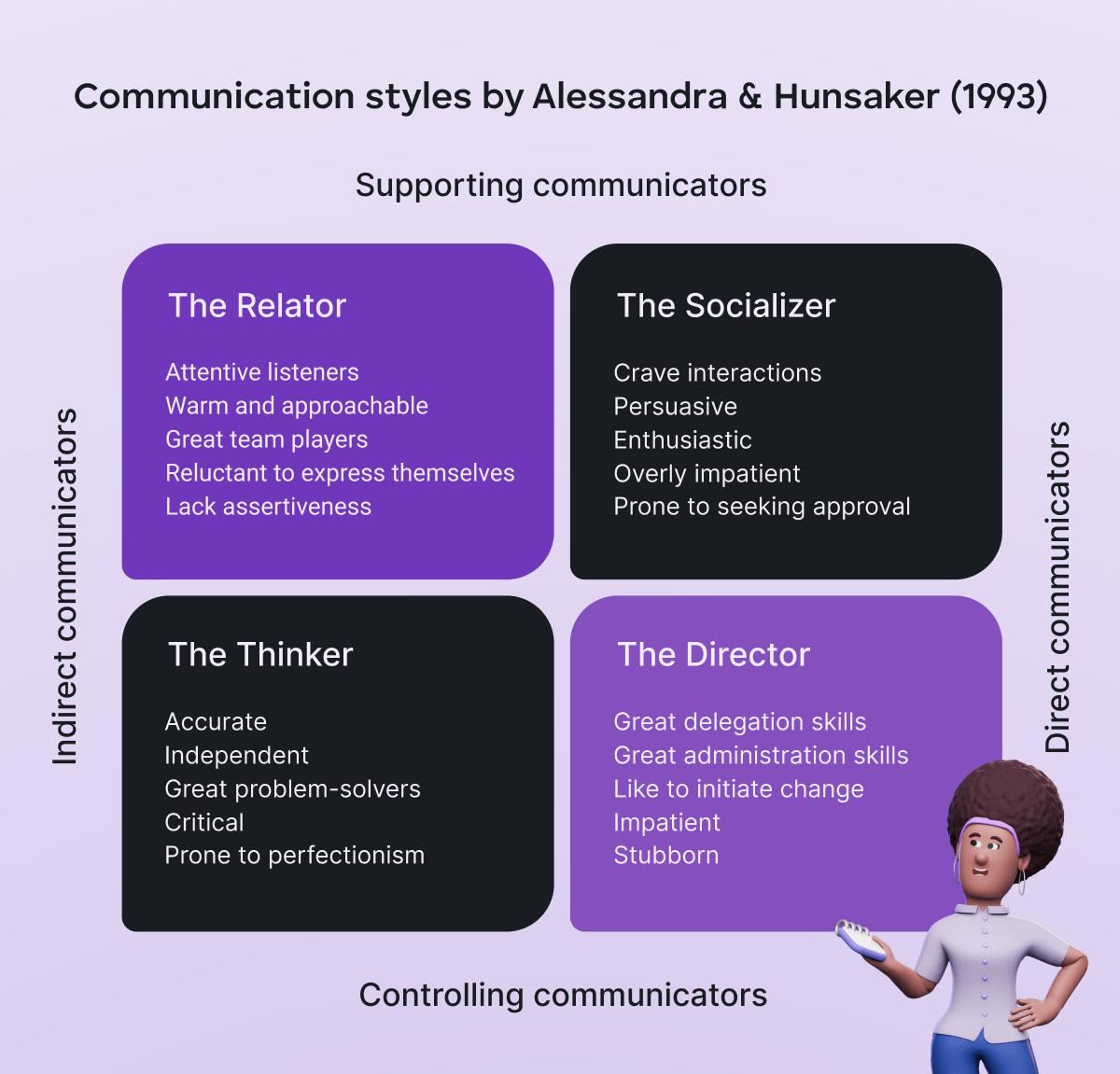
Let’s take a detailed look at what each of the 4 styles and 2 dimensions is about.
Direct vs. indirect communication styles
The direct vs. indirect dimension describes observable behavior and divides people into direct and indirect talkers.
Direct communication style
Direct talkers tend to:
- Be assertive and take charge,
- Dominate meetings with their outspoken communication,
- Radiate self-confidence,
- Maintain eye contact,
- Have firm handshakes,
- Express their opinions openly,
- Talk faster and louder in general,
- Have a bold visual appearance,
- Speak in aggressive tones,
- Be impatient,
- Be competitive, and
- Be more confrontational in general.
Indirect communication style
On the flip side, indirect talkers tend to:
- Hesitate to contribute in meetings due to their tentative communication approach,
- Take less initiative at social gatherings,
- Preface their statements with qualifications like “According to my sources…” and “I’m not sure, but…”,
- Conform about unimportant matters, but argue if they have strong convictions about something,
- Listen to others more,
- Have gentle handshakes,
- Be more reserved,
- Be more cautious,
- Talk slower and with a lower volume,
- Be more conservative in their visual appearance, and
- Be more patient, diplomatic, and cooperative in general.
Supporting vs. controlling communication styles
The supporting vs. controlling dimension describes the “why” aspect of the communication process and whether the communicators are supporting (people-oriented) or controlling (task-oriented).
Supporting (people-oriented) communicators
Supporting (people-oriented) communicators tend to:
- Maintain closer proximity with the people they are communicating with,
- Share feelings in the sense that they have no problem expressing confusion, joy, sadness, and other emotions,
- Use more informal speech patterns,
- Prefer relaxed, warmer relationships,
- Enjoy amusing conversations,
- Like to share personal stories and anecdotes,
- Pay less notice if someone is objectively wasting their time,
- Base their decisions around their feelings, but also the feelings of others,
- Have active facial expressions,
- Have animated physical gestures, and
- Be contact-oriented.
Controlling (task-oriented) communicators
Controlling (task-oriented) communicators tend to:
- Keep their distance from others while communicating,
- Base their decisions around facts,
- Share their feelings less,
- Prefer working alone,
- Pay less attention to the opinions and feelings of other people,
- Excel at time management,
- Dislike digressions,
- Use more formal speech patterns,
- Use fewer facial expressions,
- Are guarded emotionally, physically, and mentally,
- Avoid being boisterous, and
- Avoid being rowdy.
Now that we understand the dimensions that shape their communication, let’s look at how relators, socializers, thinkers, and directors communicate.
#1 Relators’ communication style
Relators are characterized by a supporting and indirect communication style.
They usually care more about the feelings of the people they are communicating with than the effectiveness of their tasks.
They tend to:
- Avoid conflict and
- Enjoy personal relationships.
Positive traits of relators
Those with a relating communication style have numerous positive traits, which commonly include:
- Being great team players,
- Being loyal to their cause,
- Being willing to share responsibilities,
- Being risk-averse,
- Excelling at active listening,
- Planning everything thoroughly, and then following through with their plans,
- Having a relaxed disposition, and
- Having a warm and approachable conduct.
Negative traits of relators
When it comes to the negative traits of people who have a relating communication style, they tend to:
- Be reluctant to express themselves,
- Struggle with setting goals,
- Not always speak up to voice their concerns, even if they disagree with what’s being discussed, and
- Lack assertiveness.
How to talk with a relator
When talking with a relator, the key point is to make the interaction personal.
To make the most of your communication with a relator, you should also:
- Be patient when trying to establish rapport and while waiting for the relator to think about the points you’ve raised,
- Seek a mutual agreement about the goals and deadlines,
- Show interest in the relator as a person,
- Explain how certain changes and innovations can benefit the relators,
- Reduce their fears,
- Follow through with your promises, and
- Exhibit warmth when communicating.
An example of successful communication with a relator
Now, let’s see how the above-mentioned characteristics manifest in workplace communication.
A CTO wants their full-stack software developer, a relator communicator, to tweak the sorting feature in their time zone converter app so that it sorts cities the user wants to compare in terms of time zone by geographical location, and not alphabetically.
The CTO starts the conversation by disclosing some benefits of such a change and being patient. At the same time, the full-stack developer considers the actual value of such a feature and asks for the optimal time for a deadline if the feature has been greenlit.
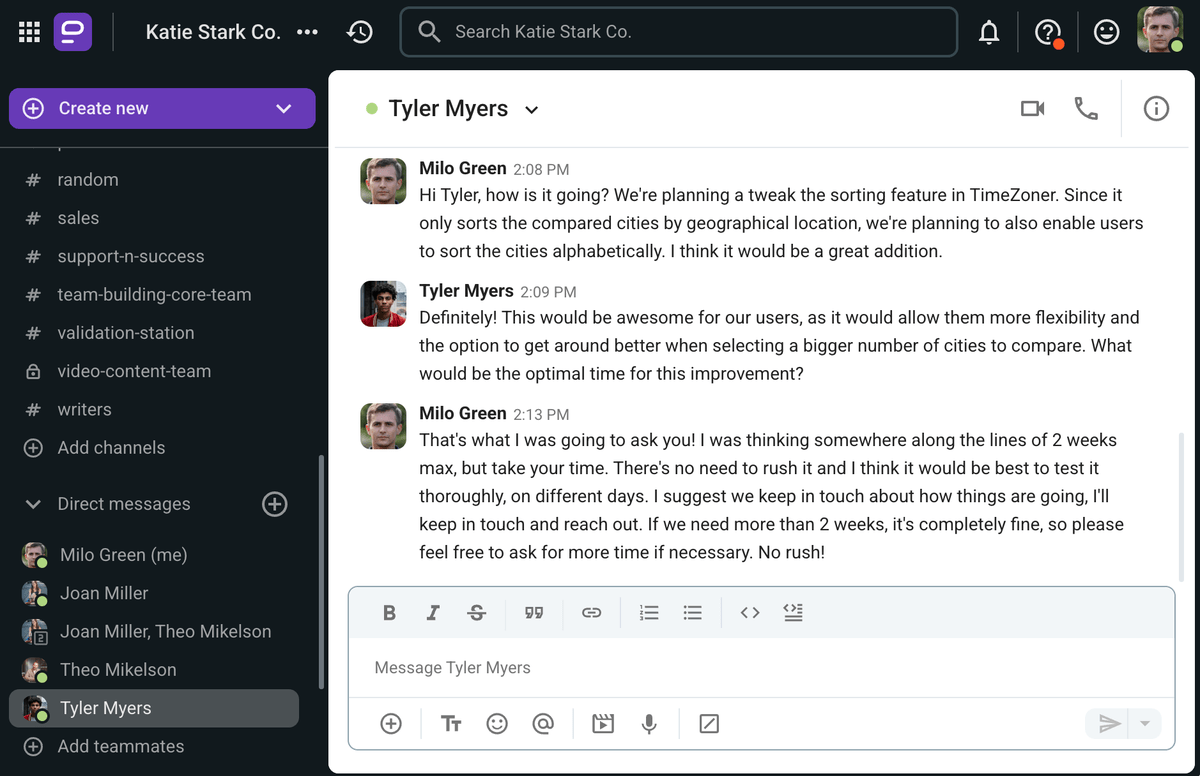
How to be a better communicator when you’re a relator
The main thing to remember if you want to improve your communication as a relator is not to let interpersonal relationships stand in the way of getting things done.
To become better at communicating as a relator, you should:
- Voice your opinions and concerns,
- Learn not to shy away from conflict,
- Remember it’s not your responsibility to take care of everyone’s personal problems,
- Not let emotions cloud your judgment,
- Try to set SMART goals and stick to them, and
- Get more comfortable with change.
#2 Socializers’ communication style
Socializers are characterized by a supporting and direct communication style.
Their strongest stimuli are the admiration, compliments, and acknowledgment they may get from others. Socializers tend to influence and stimulate others in a friendly and positive way.
Their behavior usually entails:
- Craving interactions and contact with other people,
- Acting and making decisions spontaneously,
- Acting enthusiastically and lively,
- Thinking emotionally,
- Avoiding conflicts, and
- Liking innovations.
Positive traits of socializers
When it comes to their positive traits, socializers are most commonly:
- Easy to cooperate with,
- Talkative,
- Communicative,
- Persuasive,
- Enthusiastic, and
- Social.
Negative traits of socializers
When it comes to the negative traits of people who have a socializing communication style, these people can sometimes:
- Come across as manipulative and reckless when they display behavior that is inappropriate to the current situation,
- Overlook crucial facts and details, which may lead them to exaggerate and generalize issues and concepts,
- Need help getting organized,
- Get involved in too many activities,
- Exhibit a short attention span,
- Be overly concerned with the approval of others, and
- Be overly impatient.
How to talk with a socializer
The critical point to remember when talking with a socializer is to make the interaction fun and lively.
To make the exchange pleasant and productive, you should also:
- Invest some time into building a relationship with the socializer,
- Skip the boring or unimportant details while conversing,
- Be clear on duties and responsibilities during meetings,
- Put what you’ve agreed on during a verbal conversation in writing to help the socializer remember what has been agreed on,
- Avoid criticizing them directly, and
- Try to motivate them with praise where and when due.
An example of successful communication with a socializer
Let’s now look at an example of how to apply the above-listed tips.
The director of a customer support team wants their new customer support specialist, a socializer communicator, to take on their first ticket.
While providing additional explanations about the expected workflow (e.g. “Take tickets in the order they are added, unless there are tickets that are marked as priorities”) and performance indicators (e.g. “Aim to complete the routine tickets in 30 minutes or less”), the customer support director skips the details and focuses on the gist of the duties and responsibilities of the new customer support specialist. The director also provides praise for how the new team member handled their first ticket.
In the end, the director sends an onboarding document so that the specialist can access the expected workflows, performance indicators, and other information relevant to their duties.

How to be a better communicator when you’re a socializer
As a socializer, you have no problem building rapport with your coworkers and motivating them, but you need to work on your focus and persistence.
To become a better communicator, you should:
- Work on your organization skills,
- Learn to self-validate instead of seeking approval from others,
- Pay more attention to details,
- Be careful not to overwhelm or distract quieter coworkers,
- Pay attention to whether you’re being manipulative (e.g., coercing someone into something by complimenting them), and
- Respect others’ boundaries.
#3 Thinkers’ communication style
Thinkers are characterized by a controlling and indirect communication style.
They focus on expectations and outcomes, so they base their communication around questions about how something should work to determine whether something really works.
They tend to:
- Ask more questions,
- Prefer organization and structure in work, and
- Have a logical and task-oriented way of thinking.
Positive traits of thinkers
Thinkers have several positive characteristics due to their communication style, including:
- Being accurate,
- Being independent,
- Excelling at problem-solving and organization,
- Excelling at providing clarifications, and
- Following through on their commitments and responsibilities.
Negative traits of thinkers
When contemplating the negative traits of people with this communication style, keep in mind that these individuals tend to:
- Aim to always be right,
- Be perfectionists who overanalyze, and
- Be overly critical if they think a process is not going according to plan.
How to talk with a thinker
When talking with a thinker, the key is to make the interaction accurate.
In addition, you should:
- Avoid small talk and too much socializing,
- Give them time to think about what you’re talking about before replying,
- Be prepared to answer questions with precision,
- Be prepared to provide additional figures and facts,
- Put what you’ve agreed on in writing, and
- Keep your promises.
An example of successful communication with a thinker
What happens when two thinkers meet? It’s time to find out with our example.
Two history professors are discussing the lesson plans for the following week.
Since they both fit the description of thinkers in terms of their communication style, they avoid small talk, focusing on precise details (e.g. the number of minutes they plan to spend on each class activity) and writing down what they agreed on, as they agree on it.
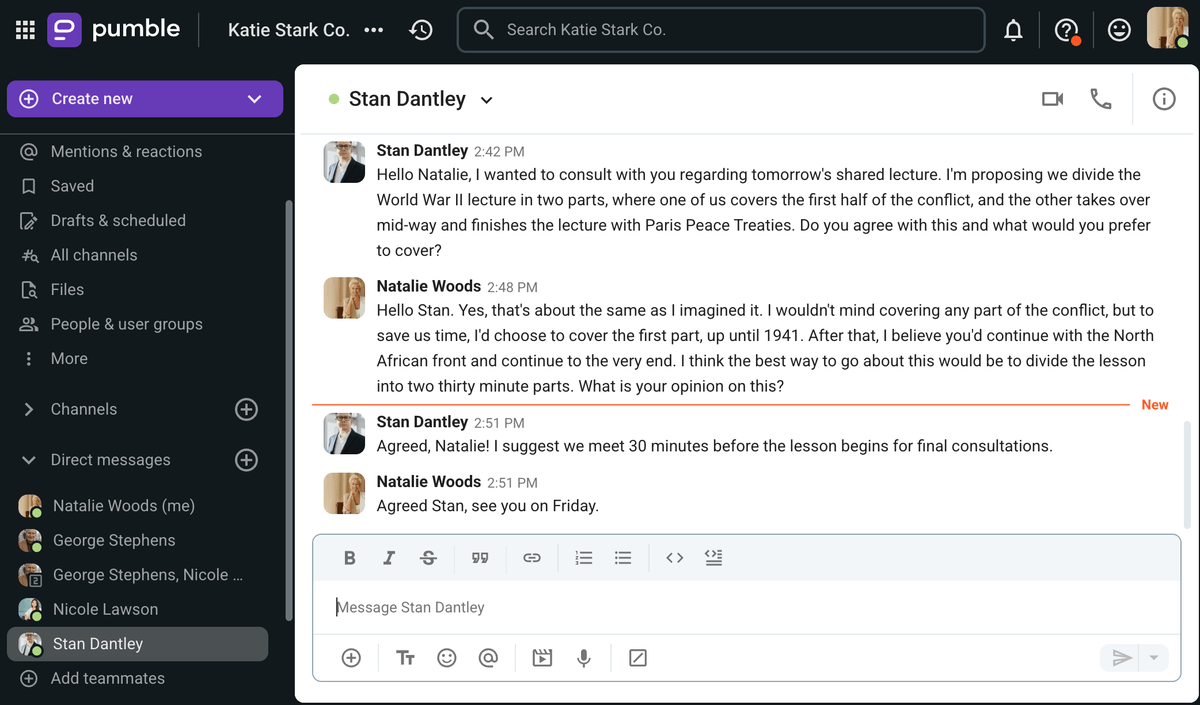
Share ideas with your coworkers on Pumble
How to be a better communicator when you’re a thinker
The biggest communication challenge for thinkers is that they’re too entrenched in facts and figures. They could benefit from loosening up from time to time.
To become better communicators, thinkers should:
- Try to engage in water cooler talk with their colleagues every now and then,
- Learn to step away from details and look at the bigger picture,
- Accept that they’re not always right,
- Work to overcome perfectionism, as it can be debilitating and make their ideas rigid,
- Strive to become more open to change, and
- Take more risks.
#4 Directors communication style
Directors are characterized by a controlling and direct communication style.
They are usually described as action-oriented leaders who are focused primarily on results.
They usually:
- Like being in control during communication,
- Have good leadership skills, and
- Prefer to act rather than wait.
Positive traits of directors
People with this communication style are a good fit for leadership positions because of their positive traits, which include:
- Being independent,
- Working quickly, even when working alone,
- Going the extra mile to overcome obstacles as fast as possible,
- Having great delegation skills,
- Having excellent administration skills, and
- Initiating changes.
Negative traits of directors
This communication style also comes with a few negative traits. Namely, directors can often:
- Be stubborn,
- Be impatient,
- Be tough, and
- Have a low tolerance for the feelings of others.
How to talk with a director
When talking with a director, aim to make the interaction fast.
To make sure no mishaps and blunders disrupt communication, you should also:
- Be clear,
- Be precise,
- Be concrete,
- Be prepared to provide quick solutions,
- Provide step-by-step guides on how goals can be obtained,
- Avoid emotional arguments,
- Avoid small talk,
- Avoid disclosing too much detail, and
- Highlight crucial points.
An example of successful communication with a director
Let’s examine how a successful exchange with a director would go with the below example.
A marketing director is having a meeting with the company’s CEO — who fits the description of a director in terms of communication style — about the marketing strategies for the upcoming period.
To say what she wants as efficiently as possible, the marketing director shows a step-by-step guide on how the marketing strategy she’s proposing can help the company obtain its goals.
She is also investing extra effort to be clear, precise, concrete, and fast and to highlight only the crucial details.

How to be a better communicator when you’re a director
A director can be a fearless risk-taker who gets the job done efficiently, but their biggest problem in communication is that they can come across as aggressive and intimidating.
If they want to become better communicators, directors should do the following:
- Try to be more considerate of other people’s feelings,
- Be more open to others’ ideas and criticism,
- Try to build genuine rapport with colleagues,
- Work on their collaboration skills, and
- Strive to become more patient.
🎓 Pumble Pro Tip
Directors are most often leaders of a team. If you like to try out a different leadership communication style, check out:
Communication styles by Murphy et al.
Mark Murphy and his team, who have spent a decade researching interpersonal communication, recognize 4 communication styles:
- Analytical,
- Intuitive,
- Functional, and
- Personal.
These styles of communication describe how we prefer to communicate information.
According to a Forbes article, as much as 42% of survey respondents who identify with at least one of the above-listed communication styles, cite the differences in these styles as the leading cause of miscommunication at work.
But, in contrast, as much as 52% of survey respondents also declare that they enjoy communicating with people who have different styles of communication. So, there is hope for a conscious effort toward improvements that will minimize miscommunication.
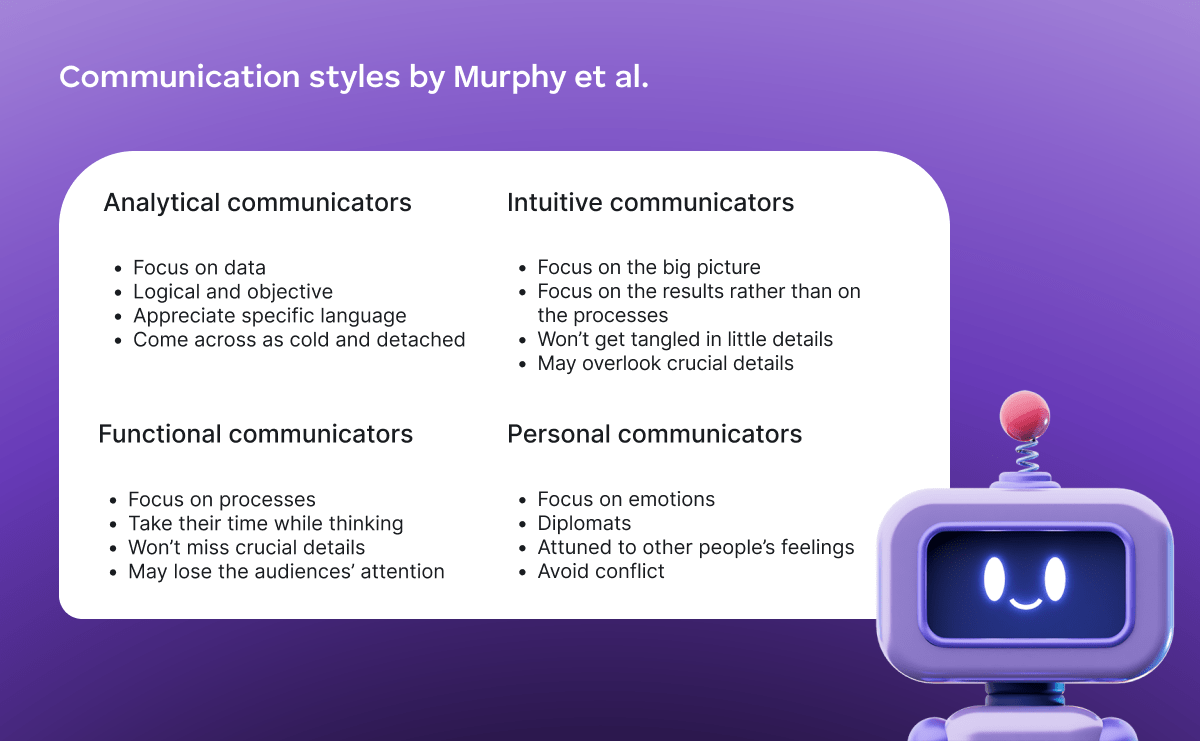
Here’s what each of these communication styles is about in more detail, as described by Murphy and his team.
#1 The analytical communication style
People who have an analytical communication style are focused on data.
In communication, they appreciate people who use specific language and enjoy conversing about facts and figures — if you don’t have the facts and figures to support your claims, you may lose credibility in the eyes of an analytical communicator.
An example of communication with an analytical communicator
Now, let’s examine how a data-driven approach works in workplace communication.
During a daily meeting, a sales specialist declares that his findings show that “sales are positive.” The sales director is unsatisfied with such phrasing and asks: “What do positive sales mean? Are they positive by 10%? Or 5%? What are the exact numbers?”
Pros and cons of the analytical communication style
Considering that analytical communicators are capable of having an unemotional view of a situation, they are also capable of analyzing and drawing conclusions about issues:
- Logically,
- Factually, and
- Objectively.
On the same note, an overly unemotional view of situations may make analytical communicators come across as cold or detached by others — especially by personal communicators.
Tips for communication with an analytical communicator
As mentioned, to appeal to an analytical communicator, you should be direct and specific. They don’t appreciate their interlocutors’ slipping into detours and irrelevant data, so stay on-point.
You should also:
- Avoid small talk,
- Focus on business, and
- Avoid personal subjects.
Always keep in mind that analytical communicators aren’t ones to offer a shoulder to cry on.
Tips for communication when you’re an analytical communicator
As an analytical communicator, you could benefit from being friendlier to coworkers and showing more tolerance for chattier and warmer personalities.
Understand that not everyone processes information like you nor has a propensity for crunching numbers, and try to be more patient when someone gets distracted.
#2 The personal communication style
People who have a personal communication style are focused on emotions.
In communication, personal communicators value emotional language and establishing a connection with the people they are communicating with.
As a result, they tend to be diplomats and excel at listening, because they find great value in assessing how other people think and feel.
An example of communication with a personal communicator
Why would you want a personal communicator to join your team or organization? Review the below example and decide for yourself.
While discussing the color scheme for their newest product, a product designer notices that their newest junior product designer seems upset over being overlooked for ideas.
Consequently, she makes an effort to make the junior product designer feel more included and appreciated by addressing him and asking about his opinion.
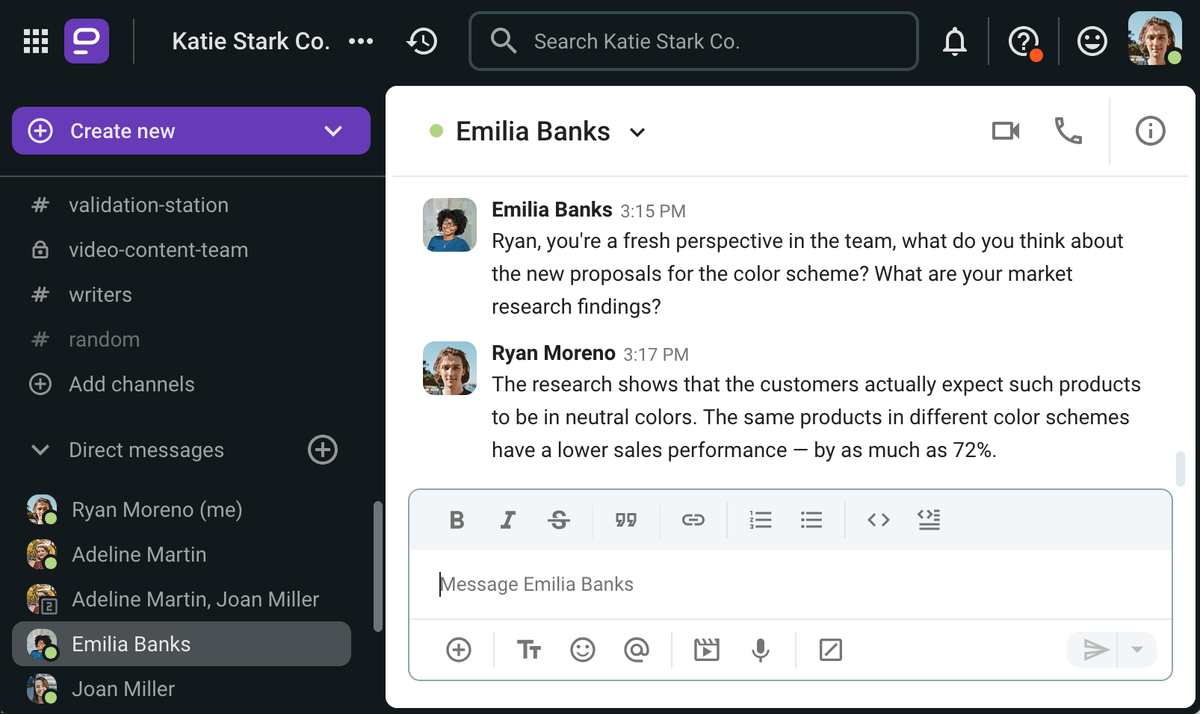
Brainstorm effectively in Pumble
Pros and cons of the personal communication style
Personal communicators often serve as the glue that holds everything together — they are attuned to other people’s feelings and opinions, which helps them smooth over conflicts and encourage others to share ideas and opinions.
The emotional side of personal communicators serves as both their upside and their downside — they may be viewed as overly emotional individuals who can easily get upset, especially from the point of view of analytical communicators.
Moreover, their emotional side may drive them to avoid conflict, even when a battle of opinions may be the most productive outcome.
Tips for communication with a personal communicator
Before delving into business with personal communicators, it’s best to take a little time to get to know them and acknowledge them as human beings first.
Make them feel their point of view is valuable, and check in with them regularly to see how they feel about a certain idea, decision, or the like. Feel free to use emotionally charged language and avoid speaking matter-of-factly.
Tips for communication when you’re a personal communicator
When talking to your more analytical colleagues, try not to take their straight-to-business manner personally. Respect the fact that some people don’t want to engage in warm and fuzzy relationships, especially at work.
Also, don’t hesitate to express disagreement just because you fear it might result in conflict.
#3 The intuitive communication style
People who have an intuitive communication style are focused on the big picture.
In communication, they dislike excessive details and prefer broad overviews to a perfect ordering of events or explanations of the issue or situation.
They are action-oriented and focused more on results than the process that will get them there. In line with that, they favor brief conversations that cut right to the chase.
An example of communication with an intuitive communicator
As you may have guessed, an intuitive communicator often prevents conversations from going off-track, as evidenced by the following example.
During a one-on-one meeting between a financial services officer and a financial consultant, the financial services officer starts disclosing details about the account of a client who wishes to invest in stocks. The financial consultant feels like the details are excessive and exclaims: “Let’s just focus on the current financial position of the client and go from there.”
Pros and cons of the intuitive communication style
Considering that intuitive communicators prefer to-the-point conversations, they won’t get tangled in little, insignificant details.
Their habit of looking at the bigger picture may also help them find innovative, new solutions to old problems that suffer from inefficient processes.
However, the briefness intuitive communicators favor while communicating means they may lack patience during situations that require a more detailed, prolonged approach.
In such cases, these communicators may miss a crucial detail while looking at the bigger picture — which may especially frustrate functional communicators.
Tips for communication with an intuitive communicator
If you want to capture the attention of this type of communicator, you need to paint in broad strokes.
This is especially important if you’re trying to pitch them an idea — don’t bother them with the details of planning and execution.
Instead, focus on the why and email them the how later.
Tips for communication when you’re an intuitive communicator
It’s great that you’re a visionary and a person of action, but you should also express interest in the processes and not just the results.
These bits of information will help you discover any potential bottlenecks and even deal-breakers before it’s too late and allow you to better explain your ideas.
#4 The functional communication style
People who have a functional communication style are focused on processes.
Functional communicators dislike the cut-to-the-chase, speedy conversations preferred by intuitive communicators.
In contrast, they like to focus on details and processes and take their time while looking for solutions and new ideas.
An example of communication with a functional communicator
The below situation highlights how the detail-oriented approach of functional communicators affects conversation.
The head of the editing department is talking with a video director who is creating a new marketing video.
The head of the department asks about the details and takes a longer time to figure out everything that might be important for the video and its purpose.
While looking for the proper approach, the head of editing department is:
- Methodical,
- Process-driven, and
- Detail-oriented.

Pros and cons of the functional communication style
A functional communicator is unlikely to miss crucial details in a concept, idea, or a plan, no matter how small and insignificant this detail may appear to other people.
However, considering that they prefer to take their time while thinking about or explaining something, functional communicators risk losing the attention of their intended audience — especially if the said audience includes intuitive communicators.
Tips for communication with a functional communicator
When you want to discuss an idea with a functional communicator, you better come prepared! They will want to hear all the technical details and will easily poke holes in your plan.
On the other hand, you can use their scrupulousness to test the viability of your ideas. Feel free to leave out the big talk and serenades and focus on the practical side of the issue at hand.
Tips for communication when you’re a functional communicator
Try to estimate which social situations call for thorough explanations and which don’t.
For example, if you’re trying to sell an idea or product, you don’t want to bore potential buyers with the technical how-to at the first meeting.
You can leave that part for your internal team discussions and instead focus on how your product will fit their vision or need.
Workplace communication styles by Cox
In his book Negotiations: How to Achieve Win-Win Outcomes, author and training consultant Geof Cox touches on effective communication, outlining 4 distinct types of communication styles.
When it comes to workplace communication, Cox elaborates that people, more often than not, employ one of the following communication styles:
- The action-oriented style,
- The process-oriented style,
- The people-oriented style, and
- The idea-oriented style.
In situations like negotiations and business meetings, the success of the exchange lies in our ability to adapt and adopt different communication styles swiftly.
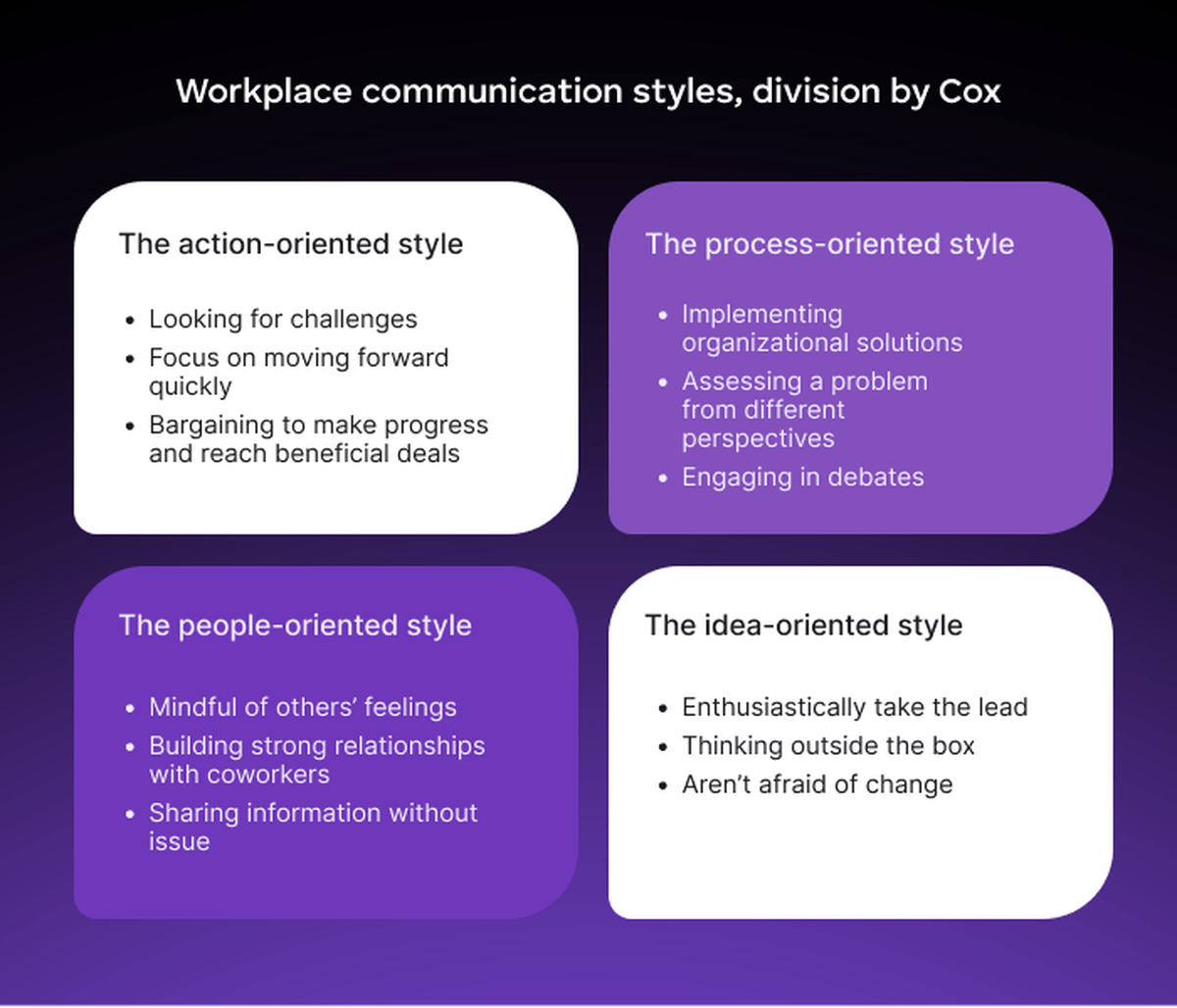
Thus, it’s essential to examine the styles of communication above in detail and learn about their strengths and potential setbacks.
#1 Action-oriented style
The mindset of action-oriented people drives them to get tasks done and achieve good results. These communicators do not fear change and strive to convert their plans into actions to improve their current situation.
Common behavior of action-oriented communicators
In general, people who prefer the action-oriented style exhibit the following behaviors:
- They often mention challenges and the possible ways of moving forward,
- They may focus on achievements and results at the expense of their coworkers’ feelings,
- They may grow impatient with people who rely on a different communication style,
- They typically stay on top of their workload and meeting deadlines, and
- They’ll gladly bargain with others to reach the best possible deal.
An example of action-oriented communication
How does using this communication style in the workplace pan out? Let’s see what our example shows.
The marketing director of a leading marketing agency is meeting the CTO of a major tech company.
The two companies have a history of collaboration, and the marketing director tells the CTO: “If you invest in our newest venture, we’ll increase advertising of your products across all our sites by 20%.”
The marketing director is employing exchanging and demanding behavior to secure a deal that will benefit both parties.
Benefits of action-oriented communication
Those with an action-oriented mindset like to keep conversations short and simple.
Instead of engaging in small talk to ease everyone into a meeting, they’re likely to cut straight to the chase, making all types of meetings and conversations more productive and preventing others from straying off-topic.
In addition, this communication style can be helpful because it:
- Allows people to reach their goals in less time,
- Helps the speaker cover a lot of ground quickly, and
- Gives the conversation an energetic tone.
Drawbacks of action-oriented communication
More than anything, action-oriented communicators want to get stuff done.
Unfortunately, while this is invaluable in any workplace, such a driven mindset can lead others to perceive the communicator as:
- Arrogant,
- Insensitive to the opinions and feelings of their coworkers or teammates,
- Dictatorial, and
- Disinterested in anything other than results.
In short, relying too heavily on the action-oriented communication style could make people believe you wish to achieve your goals without offering meaningful contributions in return.
How to talk with action-oriented communicators
When talking with an action-oriented communicator, the last thing you want to do is bore them with excess details.
As soon as they feel bombarded with unnecessary information, you risk losing them in conversations.
To make the most out of these exchanges, try to:
- Use visual aids to get your point across,
- Mention the expected results first and then follow up with additional conclusions,
- Highlight the practical values of your plans and ideas, and
- Be brief.
How to improve communication if you use the action-oriented style
As we’ve mentioned, overusing this style is ill-advised. Luckily, there are several ways people with this style can improve communication, including:
- Being patient when talking to individuals who prefer a different communication style,
- Taking into account people’s feelings when making decisions and crafting responses, and
- Listening to other peoples’ ideas and feedback without interrupting.
#2 Process-oriented style
People who utilize a process-oriented communication style want to arrive at logical solutions. Unlike individuals with an action-oriented mindset, these communicators are less forceful, using rational arguments instead to achieve desired outcomes.
The common behavior of process-oriented communicators
Process-oriented communicators typically focus on the following:
- Establishing effective organizational systems,
- Approaching a situation from all possible angles to find an optimal resolution, and
- Engaging in debates.
An example of process-oriented communication
While people should avoid overusing this communication style, it’s undeniable that it can be beneficial, especially when making a detailed business plan.
Check out the below example in which a marketing assistant is speaking to their team lead about possible advertising channels for their newest campaign. Notice how the marketing assistant goes over every detail. Their response bears all the hallmarks of process-oriented communicators.

Collaborate effectively with Pumble
Benefits of process-oriented communication
The process-oriented communication style is an excellent resort for business purposes because it:
- Encourages participation from all present parties,
- Minimizes the risk of making ill-informed and rash decisions, and
- Relies on data, facts, and analysis.
Drawbacks of process-oriented communication
Although process-oriented communicators like to weigh all sides of an argument or proposal, their communication style has several downsides.
In their desire to logically and thoroughly assess a situation, individuals who use a process-oriented communication style:
- May slip into verbosity,
- Could create a tiresome atmosphere, and
- Might hold meetings that drag on for ages before arriving at a resolution.
How to talk with process-oriented communicators
Some may feel out of depth when talking with process-oriented communicators, as this communication style employs many facts, data, and reasoning.
To ensure the conversation flows without a hitch, it’s best to:
- Break down your idea or proposal into the most important facts and details,
- Follow a logical outline when speaking, and
- Elaborate on the current situation first and ease into expected outcomes afterward.
How to improve communication if you are a process-oriented communicator
Having your facts and data straight is always good, but focusing too much on minute details can detract from the big picture.
Instead of that, try to:
- Limit yourself to using a maximum of 3 facts to back a proposal, decision, or opinion,
- Delegate tasks to others so that you don’t have to spend too much time analyzing a problem without assistance,
- Stop yourself when you realize you’ve been talking for too long, and
- Ask others to provide input and feedback.
#3 People-oriented style
Those with a people-oriented communication style are in tune with other people’s needs and make a conscious effort not to infringe on the rights of all conversation participants.
They are understanding, emphatic individuals whose guiding principles include teamwork and a solid sense of ethics.
Common behavior of people-oriented communicators
Empathetic and sensitive, communicators with this style strive to:
- Understand the feelings and motivations of other people,
- Build strong relationships with coworkers and teammates, and
- Openly share information with others to build trust.
An example of people-oriented communication
How does people-oriented communication transpire on the job? We can use the below conversation as an example.
An app developer is reaching out to her team lead via Pumble, a business communication app. Note how she drafts her message.

In the first part of the message, the developer voices her feelings about the current situation, which constitutes sharing.
On the other hand, the final part of the message invites the team lead to share information, demonstrating the developer is ready to listen to their response.
Since sharing and listening form a cycle in people-oriented communication, this style is a useful business strategy.
🎓 Pumble Pro Tip
Business communication can seem complex, and understanding its ins and outs can be challenging. Check out our beginner’s guide to business communication to learn more and resolve any lingering questions:
Benefits of people-oriented communication
The people-oriented communication style rests on sharing and listening.
When we open up to other people, we invite them to trust us, which compels them to reveal more about their own feelings and values.
When it comes to workplace communication, such insight can significantly improve decision making, especially when negotiating a deal or writing up a proposal.
In addition, the people-oriented communication style:
- Creates a positive environment where conversation participants feel seen and heard,
- Bolsters team spirit and communication,
- Promotes empathetic listening, and
- Builds rapport.
🎓 Pumble Pro Tip
Building a strong and harmonious team relies on trust, which can be hard to build in a remote work environment. Read up on this topic and learn how to tend a trusting relationship in the workplace:
Drawbacks of people-oriented communication
Whether you’re communicating with a potential business partner or a long-time client, this communication style is an excellent strategy that can yield valuable insight.
However, it can also lead to several problems, some of which include:
- Oversharing — It could deteriorate trust when people feel bombarded with unnecessary information.
- Selective or overly attentive listening — You might try to overcompensate when you open up too much by listening too attentively. Or, you may forget to pay close attention to what others say. Either way, other people could feel you are attempting to manipulate them.
How to talk with people-oriented communicators
People-oriented communicators are usually friendly and approachable, so it’s easy to bypass any communication barriers relatively quickly.
The following tips will help ensure that the conversation flows smoothly:
- Ask follow-up questions after they’ve finished talking to show you’ve paid attention to their words,
- Observe both their verbal cues and non-verbal cues to interpret their message, and
- When you need clarification on whether you’ve understood them correctly, summarize the communicator’s point and ask for confirmation.
#4 Idea-oriented style
People who employ the idea-oriented communication style view the world in terms of:
- Models,
- Concepts,
- Theories, and
- Abstractions.
They’ll usually have a future-oriented approach and are always on the lookout for new possibilities.
Common behavior of idea-oriented communicators
Regardless of whether they’re working on business or personal goals, idea-oriented communicators are most often:
- Not afraid to take the lead to bring their vision to life,
- Creative thinkers who are willing to try new and innovative solutions,
- Undaunted by change,
- Up to speed with the latest developments in their field of interest, and
- Trying to inspire teammates and coworkers to think outside the box.
An example of idea-oriented communication
The below example underscores both the advantages and disadvantages of idea-oriented communication.
A language school owner is talking to the co-owner, sharing their plans to revamp their lesson plans.
The owner states: “The updated PDFs can include QR codes that lead to interactive online exercises, and we can add attractive visual elements recapping the core of the lessons.”
While these seem like good ideas, there’s no mention of a deadline or whether the employees have the technical skills to pull off this feat.
Benefits of idea-oriented communication
People with an idea-oriented communication style feel they’ve done their best work when collaboration is at its highest.
Consequently, some of the rewards of this type of communication are:
- A shared vision that helps team members stay on track,
- Strong connections between people who collaborate on a day-to-day basis,
- Refocusing coworkers’ attention on the big picture, and
- Bolstered cooperation, because multiple people have focused their efforts in the same direction.
Drawbacks of idea-oriented communication
Like the previously discussed communication styles, the idea-oriented type may not always be ideal.
Most notably, the overuse of this communication style might:
- Fail to bring people together around a shared vision and
- Lead to wasted opportunities if it directs energy in the wrong direction.
How to talk with idea-oriented communicators
When connecting to an idea-oriented person, remember to keep conceptual thinking at the core of the conversation and:
- Explain how your idea relates to bigger issues,
- Elaborate on what makes your idea innovative and unique, and
- Underscore the long-term value of your proposition.
How to improve communication if you have an idea-oriented mindset
To avoid falling victim to unrealistic goals and lofty plans, keep the following things in mind if you are an idea-oriented person:
- Think about your idea more thoroughly,
- Make sure your proposition appeals to your coworkers or teammates,
- Set realistic expectations,
- Set deadlines to remain accountable, and
- Work on solidifying an action plan as soon as possible.
4 types of communication styles by Portolese Dias
In her book Human Relations Management, business author Laura Portolese Dias acknowledges that in addition to organizational communication systems, individuals also rely on their personal communication styles.
Portolese Dias goes on to recognize 4 distinct styles, which are:
- The expresser communication style,
- The driver communication style,
- The relator communication style, and
- The analytical communication style.
Remember that, as Portolese Dias informs readers, not one person uses solely one communication style.
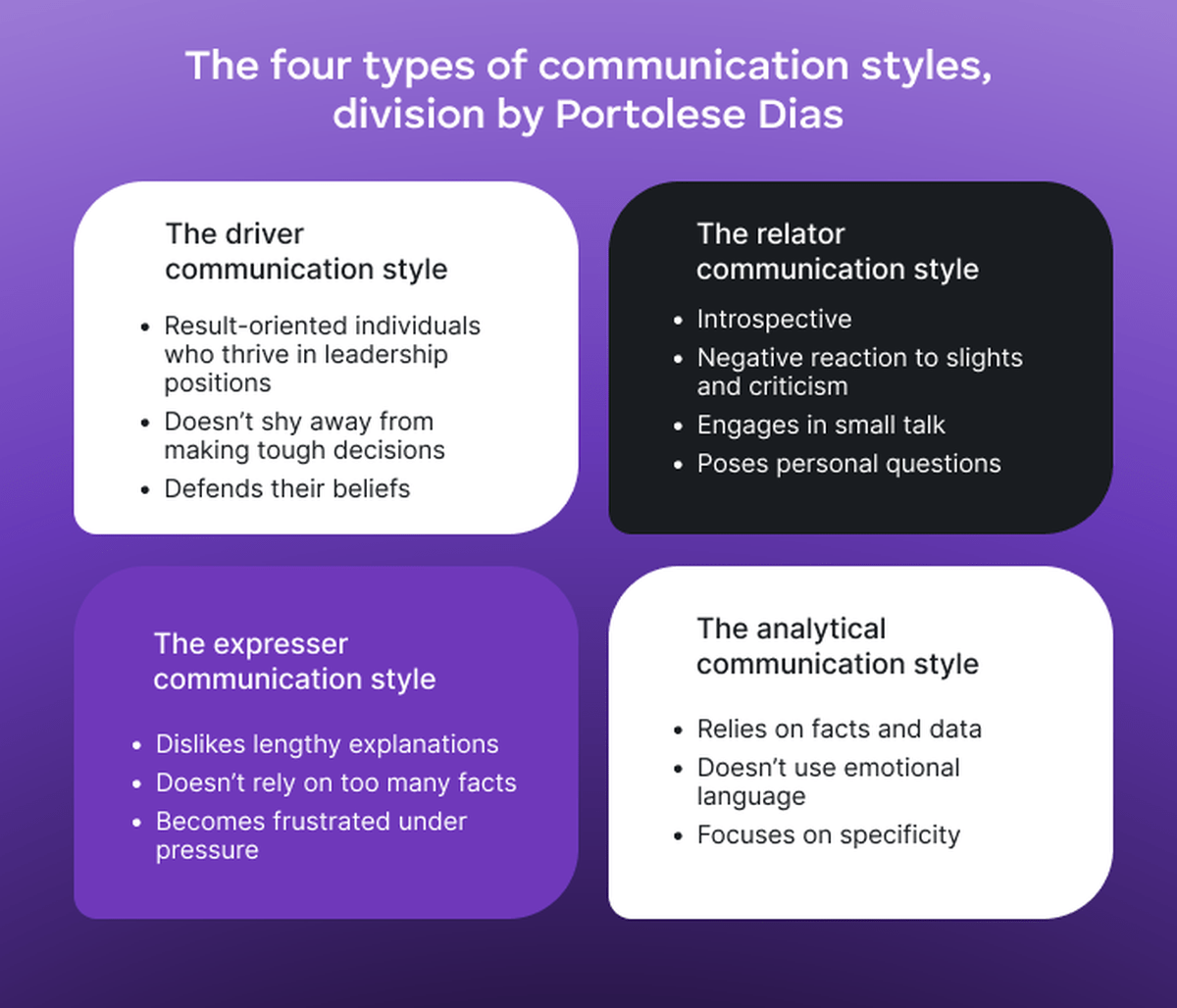
This fact, in turn, raises the importance of pinpointing your preferred ways of communication and the pros and cons of other styles.
#1 The expresser communication style
People who have an expresser communication style are typically excitable, don’t back down from challenges, and trust their gut instincts.
While trusting your instinct is usually sound advice, it can present an obstacle in circumstances that require decisions based on facts and hard data.
Common behavior of expressers
It’s relatively easy to identify an expresser because they:
- Dislike boring explanations,
- Don’t reference a lot of facts,
- Grow frustrated when they feel someone is wasting their time, and
- May become argumentative when under pressure.
An example of communicating with an expresser
Since understanding how different styles of communication function in a professional setting can prevent minor miscommunications and low morale, here’s how an expresser may interact with a coworker.
A person whose dominant type of communication style fits the bill of the expresser states to their coworker: “I’m so excited about the business trip this upcoming weekend.”
The coworker thinks about this statement and responds: “I don’t think we can take the entire Friday off, so I don’t think we’ll have time to do everything we’ve discussed.”
The expresser starts feeling frustrated, replying: “I’ve been planning this trip for weeks. I’m sure everything will work out for the best.”
As in other examples we’ve examined thus far, the trouble arises when communicators with 2 different styles fail to compromise.
In the above instance, an expresser is talking to a driver. The expresser is simply happy about the trip, and the exchange goes south when they feel their coworker doesn’t want to acknowledge their efforts.
On the other hand, the driver isn’t sure that the plan is foolproof, and their questioning may seem like they’re undermining their coworker’s idea.
Pros and cons of the expresser style
Having an expresser in your corner is helpful for organizations of all sizes because these communicators:
- Encourage others to view the bright side of a situation,
- Are passionate about their work, and
- Are unlikely to back down from a challenge.
The above aspects sound excellent, but what about the downsides?
The expresser style can pose problems in workplace communication and organization because the communicator might:
- Struggle to organize their time and workload effectively,
- Miss deadlines, and
- Not be in command of all the facts relating to their task or project.
Tips for communicating with an expresser
Individuals with an expresser communication style have a lot to offer on both personal and business levels, especially if you know how to approach them and:
- Listen attentively, showing genuine interest in their words,
- Display excitement about their ideas,
- Acknowledge their contributions, and
- Provide feedback and structure so they can set realistic goals.
Communication tips for expressers
Individuals with this communication style may quickly become frustrated when miscommunications arise, but they can prevent mishaps by:
- Asking others for feedback to identify improvement areas,
- Mastering effective time management techniques,
- Devoting more time to review the minute details of an issue, and
- Trying not to take criticism personally.
#2 The driver communication style
As the name of this communication style implies, drivers prefer to take their own path.
They are decisive and driven by strong beliefs and viewpoints.
When questioned about their decisions, they’ll gladly share their reasoning. Their no-nonsense approach leaves little room for small talk or wasted time.
Common behavior of drivers
As far as their behavior in a professional setting, you can recognize drivers as they tend to:
- Seek leadership positions,
- Pose results-oriented questions (i.e., “What do we want to achieve by the end of this quarter?”),
- Stand firmly behind their viewpoints, and
- Dislike someone else making decisions for them.
An example of communicating with a driver
In terms of communication styles in leadership positions, you’ve more than likely met a few high-performers you’d class as drivers. Let’s review a practical example.
Tim, a content manager for a tech firm, is holding an end-of-the-year meeting with his team.
“Given the results we’ve had this last year, we can proceed as planned during the next few months. So, we’ll focus on polishing the marketing material for the upcoming campaign and start publishing the introductory texts in 2 weeks.
Then, we’ll shift gears and focus on lengthier texts. The only thing left is finalizing our new social media strategy, which is the first thing we’ll review in the next meeting. Any questions?”
Tim’s talk is direct and to the point, and he makes it clear that he’s in control of the work and has a good idea of how to steer his team in the coming period.
🎓 Pumble Pro Tip
When in a leadership position, drivers lean toward a strategic approach. To better learn how to communicate with such individuals, read up on their working style:
Pros and cons of the driver style
People with this communication style apply this matter-of-fact approach to both their personal and professional life, meaning that:
- They remind others to focus on the most urgent tasks first,
- They know how to assert themselves in competitive situations, and
- They always strive to find the most time-efficient solutions.
However, being overly reliant on this communication style may backfire and:
- Hurt the feelings of others,
- Lower team morale, and
- Minimize cooperation.
Tips for communicating with a driver
When drivers feel like someone’s backed them into a corner and usurped control, their instinct may be to become stubborn. Consequently, their communication could gain a more aggressive edge.
To successfully connect with them and provide them with ample room for success, try to:
- Listen attentively without interrupting,
- Kick off the conversation by mentioning the desired results, and
- Encourage them to cooperate with others.
Communication tips for drivers
Although drivers care for little else than winning when they get into a competitive situation, they should still aim to:
- Respect the feelings and boundaries of others,
- Not infringe on the responsibilities of their coworkers, and
- Learn when to back down and shift tactics.
#3 The relator communication style
Like Alessandra and Hunsaker, Portolese Dias recognizes relators as one of the 4 types of communication styles.
People who use this style dread rejection and fear others will dismiss their suggestions and ideas. As a result, they may become silent and withdrawn when challenged.
However, they value close personal relationships and do their best work when they feel seen, heard, and supported.
Common behavior of relators
Individuals with a relating communication style tend to:
- Turn introspective when they feel someone is treating them in an uncaring manner,
- Thrive when others show enthusiasm and care about their work,
- React negatively to perceived personal slights,
- Ask personal questions that often don’t relate to their work, and
- Frequently engage in small talk.
An example of communicating with a relator
While some wouldn’t assume being a relator is one of the more effective workplace styles of communication, you can still get things done and strike a friendly tone, as evidenced by the following example.

Communicate better with your team — Use Pumble
Knowing that they’re dealing with a relator, the manager follows their lead, showing interest in what they’ve disclosed about their personal life before steering the conversation in a more professional direction.
Pros and cons of the relator style
Those with this communication style are genuinely interested in nurturing close relationships with those around them.
Their interest creates a positive atmosphere that can encourage introverted people and more passive communicators to come out of their shells.
However, relators may have trouble focusing on the topic at hand, inadvertently going on tangents about personal matters. Their accidental rants can frustrate coworkers, especially those with a more analytical communication style.
Tips for communicating with a relator
In addition to showing care about what relators are sharing, provide sufficient detail about upcoming tasks. This information helps keep relators accountable and allows them to develop feasible plans.
Communication tips for relators
If you most closely identify with the relating communication style, practice finding a line between small talk and mindless chit-chat.
Investing time and effort into building close bonds with others is admirable, but should you overdo it, you might lose sight of the activities you need to accomplish.
#4 The analytical communication style
Those with an analytical communication style typically espouse a methodical mindset, and their logical approach also shows up in their communication.
When faced with an issue, an analytical communicator will try to assess all facets of the problem, delving deep into its technical aspects.
Common behavior of analytical communicators
People with this communication style usually:
- Base their arguments on data and facts,
- Rarely, if ever, use emotionally charged language,
- Avoid vague expressions and emphasize specificity, and
- Pose multiple questions to get to the root of an issue.
An example of communicating with an analytical communicator
So, how might such a communicator fare in a business setting? Let’s find out through the following example.

While the other person in the conversation takes time to praise their colleague, the analytical communicator does no such thing.
Instead, they continue planning and determining how to begin actions to help them achieve their goals.
Pros and cons of the analytical style
In terms of workplace communication, an analytical style can:
- Result in shorter but more productive meetings,
- Allow people to remain objective, and
- Help teams make well-informed decisions.
But, what of the drawbacks? Well, analytical communicators tend to:
- Become agitated when they make a mistake,
- Respond negatively to pressure, and
- Neglect to take into account the feelings of other people.
Tips for communicating with an analytical communicator
When speaking to a person with an analytical communication style, remember to:
- Use precise language and include numbers and other data,
- Not try to appeal to their emotions,
- Allow them to follow their own pace, and
- Suggest developing a framework to track progress.
Communication tips for analytical communicators
Analytical communicators are results-driven, which can cloud their vision, preventing them from picking up on the emotions of those around them.
Therefore, to ensure no miscommunication or hurt feelings occur, they should:
- Work on their interpersonal skills,
- Take in constructive feedback, and
- Try to connect with those around them on a more personal level.
Nourish diverse communication styles with Pumble
Navigating professional communication requires more than just words – it demands a tool that facilitates seamless collaboration and enhances overall team dynamics.
As we wrap up our exploration of various styles of communication, consider incorporating Pumble, a team communication app that will revolutionize the way your team interacts.
If you often collaborate with a socializer, you can include bullet points, relevant links, and spacing in your messages to account for a socializer’s short attention span.
If you are dealing with a manipulative communicator, Pumble can help you focus your communication, be precise and concise and get to the point more efficiently, whether through dedicated channels or direct messages.
If you’re a director, you can create channels specifically designed to take into account opinions of your subordinates — and if you find some of your team members are indirect communicators, you might encourage them to voice their opinions by voting on polls.
Whether you lean towards an assertive style or favor a more intuitive approach, Pumble accommodates and enhances your chosen communication style. Elevate your team’s communication experience, celebrate diversity in expression, and embrace the future of collaborative interactions with Pumble.
Want to find out more about how Pumble can improve your team’s communication?
How we reviewed this post: Our writers & editors monitor the posts and update them when new information becomes available, to keep them fresh and relevant.



